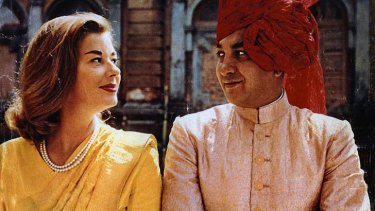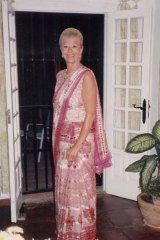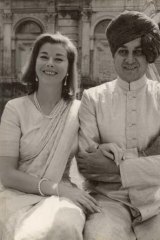Model became an Indian princess
Gina Narayan, 1930 - 2013
When a beautiful English model met a dashing Indian prince in London, it was a love match that was a true meeting of spirits, framed by India's changing political landscape. As Her Highness Maharani Gina Narayan of Cooch Behar, the new princess was expected to head her husband's palace, its household and its estates, which included of hundreds of servants, elephants and a small army.
It was not easy, she said in 2007: ''the different customs, learning to tie a sari, getting to know the mashimas and pishimas [different ranks of respected older women], and getting used to being called Her Highness''.
For more than a decade she had true love, a circle of famous friends and fabulous riches framed by the beauty and culture of India's north-east. Ultimately, though, she was shattered by the death of her husband and found it difficult to cope alone.
Advertisement
Possibly as a defensive move, she hid, or reinvented, much about herself. It didn't matter: she was an incredibly charming woman. One of her old friends from her days in India described her as ''a wonderful hostess and the life and soul of every party, yet also a well-trusted friend to so many''.
Georgina May Egan was born on May 6, 1930, in London, the only child of police constable Arthur Egan and his wife, Evelyn (nee Irons). Little is known of her childhood and early life except that it was modest. She was educated at Purley County School for Girls, Arthur died when she was young and Evelyn remarried.
Gina grew tall, slender and blonde. After leaving school she took a secretarial course in shorthand and typing but soon left that dull career behind for modelling. By 18 she was sought after in London, Paris and Italy. During the late 1940s and early '50s she worked with leading designers including Norman Hartnell and Louis Feraud, and was photographed in Vogue.
With her natural elegance and outgoing manner she was a popular member of London's flashy, celebrity-studded ''mink and martini set''. Her portrait was painted by Maurice Litten, who recorded society beauties of that era.
At a dinner party in 1956, Gina was introduced to Jagaddipendra Narayan, the 22nd Maharajah of Cooch Behar, known as ''Bhaiya'' to family and friends. The handsome maharajah was an outstanding sportsman and polo player. He had been educated at Eton, Harrow and Cambridge, had an impressive war record and was 15 years older than Egan. They were instantly enamoured and married after a three-month courtship. It was a second marriage for them both - when they met, Gina was already married to a wealthy businessman, Douglas Fisher, and divorce soon followed. Bhaiya had been married to an American starlet.
At that time there were many obstacles to an English woman's union with an Indian prince and the marriage was kept secret for three years, mainly to avoid any interference from the Indian government and the dowager maharani.
When Gina eventually arrived in Calcutta (now Kolkata) in January 1960 she was ''full of trepidation''. Cooch Behar, in north-east India at the foothills of the Himalayas, was one of India's ancient dynasties. The Maharajah's father, Jitendra Narayan, had died when he was young and his mother, Indira Devi Sahiba, had been regent until Bhaiya came of age. She was a formidable woman, as was Bhaiya's sister, Gayatri Devi, the famous beauty and Maharani of Jaipur.
In her own way, Gina possessed equal strengths, able to negotiate the complicated etiquette and political intrigue of the royal court with grace and style. It was noted with approval that she was able to wear a sari with elegance from the outset.
Quickly, Gina became the centre of the social life of Calcutta, and the hospitality at the palace at Cooch Behar and their home in Calcutta was legendary. Among the guests were European royalty, Hollywood stars Ava Gardner, William Holden and Sammy Davis jnr, and cricketers Clive Lloyd and Tony Greig.
Polo was central to their lives and Bhaiya often played the Duke of Edinburgh, the legendary Rao Raja Hanut Singh and Bhaiya's brother-in-law Jai, the Maharajah of Jaipur.
Gina loved fast cars and among her close friends was English formula one ace Stirling Moss. In London she kept an E-Type Jaguar, which she drove when she visited her mother. Ernest Hemingway taught Gina about bullfighting during her many visits to Spain. She also owned some of the best thoroughbred racehorses in India, including the famous chestnut champion Midnight Cowboy.
The royals had traditional responsibilities, too, such as holding regular audiences with their subjects, who would come asking for the Maharajah's help. One problem was man-eating tigers, which frequented the wilds around the Himalayan foothills.
In 1966, everything changed when during a polo game in Jaipur, Bhaiya fell and sustained serious brain damage. He had a series of heart attacks and needed constant medical attention until his death in 1970.
Before Bhaiya died, the couple had adopted his nephew, Virajendra Narayan, who inherited the title, but it was not a good time for the royals under the government of Indira Gandhi. The privy purse had been abolished and some family members were imprisoned. Virajendra was the last of the dynasty; gradually, it all disappeared, stolen or sold, and the vast palace lay ravaged and empty.
After Bhaiya's death, Gina moved to Calcutta. She had inherited enormous riches, including fabulous jewels, elephants, horses and the armoury, but also huge estate duties. She had so much but little cash and between the political turmoil and some bad legal advice , was left surviving on a trust fund, which became more difficult as the years went on.
Feeling vulnerable and sad, in 1980 she left India for Marbella, Spain, which had been her and Bhaiya's favourite holiday place.
Gina never married again. In company she remained engaging, outgoing and hospitable, and had many friends. But she retained that obsession with privacy; she was a reluctant correspondent and did not always answer or return phone calls. In her early 70s she came to Sydney for an extended stay with her niece and her family, who called her ''Aunty G''. The family were delighted to have her and she intended a permanent move, but, faced with visa problems - and missing her friends - she returned to Spain. After a series of illnesses she was diagnosed with cancer but that, too, she kept to herself.
Gina Narayan had no children or siblings and always said she was alone. She never returned to the palace. She is survived by numerous nephews and nieces in India and Australia, and is remembered fondly by many friends around the world.



No comments:
Post a Comment